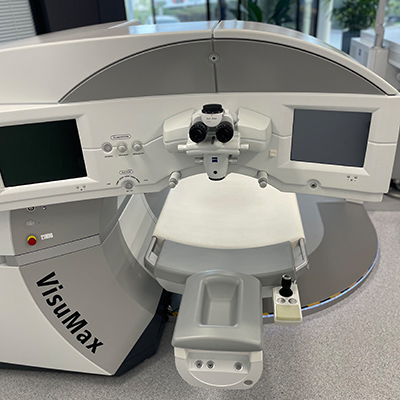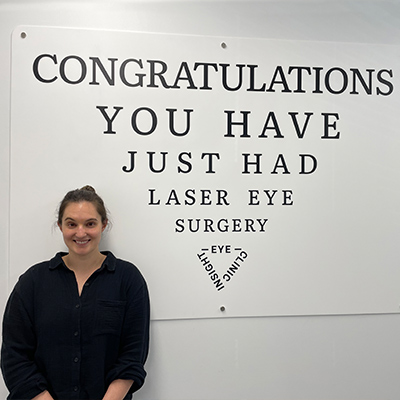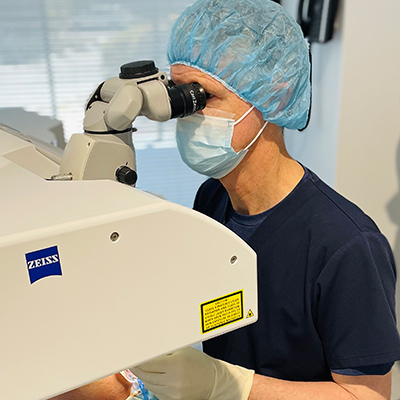Trifocal Lenses VS KAMRA Inlays
The facts on what will give you the best visual outcome
First things first, if you haven’t read my previous blogs on ‘KAMRA Inlays – Good or Bad?’ and ‘Get Amazing Vision from FineVision Trifocal Intraocular Lenses’, then they are definitely worth a read if this post has peaked your interest. Both of these posts provide background on the above mentioned refractive surgery options. They are very helpful when researching what is going to give you the best result with minimal risk.
The Presence of Risk in All Elective Procedures
When it comes to our eyes, it’s natural to want nothing but the best. Sight is considered by most to be the most important of all the senses. We  therefore; want a procedure that poses a minimal amount of risk. No risk at all would be fantastic but with any elective procedure, risk is present.
therefore; want a procedure that poses a minimal amount of risk. No risk at all would be fantastic but with any elective procedure, risk is present.
Naturally, the next step is to not only research procedures, but to research experienced reputable surgeons who can effectively and safely carry out your chosen procedure. Surgeons are obligated to outline the possible risk presence from the very small to the worst possible case scenario. Usually, these risks are accompanied by the percentage of patients that experience them to help you assess the pros and cons.
Background and Info on the KAMRA Inlay
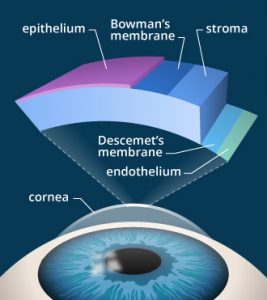 Kamra Inlays by AcuFocus have been sold and cleared for use in the EU since 2010. They are marketed in a total of 33 countries although did not receive FDA approval in the USA until June 2014. The inlay sits within the stromal bed (stroma-shown left) which is one of the layers within the cornea. Smaller and thinner than a contact lens, the inlay is a mini-ring with an opening – or pinhole – in the centre. This pinhole allows only focused light to enter your eye. Your non-KAMRA eye is left untouched.
Kamra Inlays by AcuFocus have been sold and cleared for use in the EU since 2010. They are marketed in a total of 33 countries although did not receive FDA approval in the USA until June 2014. The inlay sits within the stromal bed (stroma-shown left) which is one of the layers within the cornea. Smaller and thinner than a contact lens, the inlay is a mini-ring with an opening – or pinhole – in the centre. This pinhole allows only focused light to enter your eye. Your non-KAMRA eye is left untouched.
The lens is only suitable for patients that have very good uncorrected distance vision, otherwise, LASIK is available to correct that persons distance vision before undergoing the corneal implant. The procedure is done by using a laser to create a small pocket within the cornea and then inserting the KAMRA inlay.
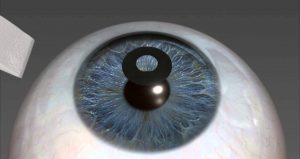
The idea behind inserting this tiny lens into the cornea is to create a pinhole effect for patients, minimising the amount of light entering the eye and allowing the patient to focus on objects up close such as their mobile phone, tablet, book, newspaper etc. It is supposed to work on the same principle as a small camera aperture by increasing the depth of focus.
But is it successful…?
From my research, there seems to be an average of 80% success using this particular method of presbyopia correction but nothing set in stone as far as ‘success rates’ go.
Claims of reversibility
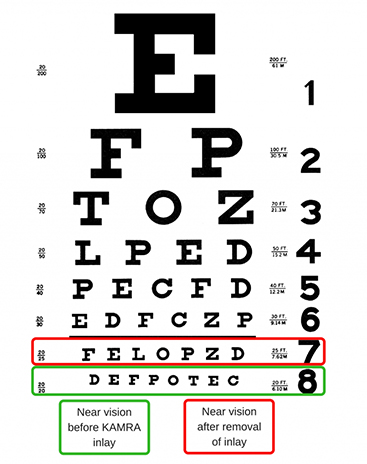
A USP for the KAMRA corneal inlay is that the procedure is reversible in case it is not successful for the individual. This sadly, is not entirely true. To suggest that the procedure is reversible is to suggest that you will go back to the exact same vision that you had prior to the implantation of the inlay. Dr Loden provided corneal consultation to one patient who had a corneal inlay removed. The result of this removal was scarring within the stroma (image above) and haze 1 year after removal. This person’s best corrected vision dropped from 20/20 to a poor quality 20/25. Removal of this patient’s inlay required a subsequent LASIK enhancement which still resulted in poorer quality of vision compared to that of what the patient had prior to his primary procedure.
Disclosure on KAMRA website (link no longer available)
Statistics

This chart comes from a report compiled by the FDA which includes a study on 508 volunteers who had the KAMRA inlay procedure. This chart shows how many people in the study experienced symptoms that they did not experience at all prior to their KAMRA inlay procedure at 6 months post-op. You can access the full study via this link for full details.

Background and Information on the Trifocal Lens
The trifocal lens that will be referred to throughout this post is the FineVision lens by Bausch & Lomb.
Trifocal RLE (refractive lens exchange) – This is a more permanent correction and involves replacing the natural clear lens inside of your eye with an artificial intraocular lens (IOL). RLE is a great alternative to laser eye surgery for those over 40 years of age. It can offer a more permanent near vision result as well as great distance and intermediate vision. By replacing the natural lens, you will never suffer with cataracts and the visual deterioration caused by cataracts.
 Not only do patients experience fantastic visual results, distance, intermediate AND near, from this method of vision correction, but it is one of the most commonly performed types of surgery in the world as it is completed in the exact same manor as a cataract surgery (removal of natural lens, replaced with artificial lens).
Not only do patients experience fantastic visual results, distance, intermediate AND near, from this method of vision correction, but it is one of the most commonly performed types of surgery in the world as it is completed in the exact same manor as a cataract surgery (removal of natural lens, replaced with artificial lens).
FineVision IOL (intra-ocular lens) Trifocal Study
In a study carried out between July – October 2011 by a group of medical professionals at Midland Eye Institute, UK (read here), only positive results came from 15 patients undergoing bilateral (both eyes) cataract surgery. The diseased lens was removed and replaced with the FineVision trifocal intra-ocular lens. The conclusion from this study reads: ‘The FineVision IOL implanted binocularly produced good distance visual acuity and near and intermediate visual function. Patients were very satisfied with their unaided near visual ability.’
The study also found…
None of the participants experienced any shadowing, halo or glare effects from the FineVision trifocal lens. This suggests that the design of the FineVision IOL, with increasing far vision dominance as pupil size increases, may be effective in minimizing halos and glare perception.
In a larger study: Clinical Outcomes With a Trifocal Intraocular Lens: A Multicenter Study…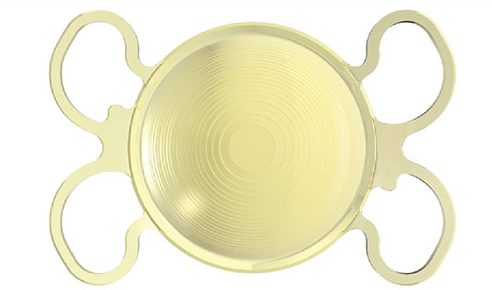
A total of 198 efile:///C:/Users/Coordinator/Downloads/clinical-outcomes-with-a-trifocal-intraocular-lens-a-multicenter….pdfyes (99 patients) were included in the analysis (122 female eyes, 72 male eyes). The final conclusion after many factors taken into consideration was: ‘The results demonstrated that the trifocal FineVision IOL is able to restore near, intermediate, and distance visual function’. Click the link in the title to view the study, its results and comments.
It’s also important to note…
that refractive lens exchange is widely recognised by health funds with some contributing to the cost for non-cataract patients. If you have cataracts and are covered by your private health fund, you are likely to receive full cover (depending on your level of cover).
KAMRA inlay procedures are not covered or recognised (that we are aware of from contact with numerous companies) by any Australian health funds.
In Summary
Better Results from Trifocal Lenses
At Insight Eye Clinic, we know that the results achieved from trifocal RLE surgery far exceed those of the KAMRA inlay. RLE surgery using a FineVision trifocal lens is proven to have less risk and less possible side effects caused by the surgery.
You can see from the links to the studies on both procedure types (above) that the outcomes were much better for those undergoing RLE using a trifocal lens than those having a KAMRA inlay procedure.
Broader Suitability Criteria with Trifocal Lenses
RLE surgery also has a much broader suitability criteria meaning most people wishing to get rid of their glasses, can do so without concern. As with any surgery, there is a possibility you might not meet the suitability criteria. Usually this is because of an existing ailment, medication, increased risk assessment or unrealistic expectations. The KAMRA inlay procedure has a very specific suitability criteria. You must have good uncorrected distance vision (wear reading glasses only) and may require additional laser vision correction to get you the results you want.

No Need for Cataract Surgery With Trifocal Lenses
When you correct your vision with a FineVision Trifocal lens, you are replacing the natural lens within the eye. The artificial lens replacement is custom made to suit your visual needs. A cataract (clouding of the lens which reduces vision) can only form on the natural lens. Once the natural lens is removed, you are no longer at risk of impaired vision caused by a cataract.
The KAMRA inlay sits within the layers of the cornea and the natural lens remains intact. For this reason, you are still at risk of cataract formation at any point (usually from age 55+). This means you will require a lens exchange procedure later in life to remove the diseased lens. This will add additional cost, additional risk and many more appointments. It is likely the inlay will need to be removed in order to perform the lens exchange.
More Procedures Performed using Trifocal Lenses
The procedure type (refractive lens exchange) is the exact same as a cataract surgery. This is the most commonly performed surgery in the world. The trifocal lens used to correct vision is the best lens available for those wanting full visual correction for distance, intermediate and near vision. This method of correction is much more popular internationally when compared to the KAMRA inlay.
Whatever option you decide suits you best, always ensure you are fully informed first. With each elective procedure comes risk of complications during surgery or post-operatively. A reputable Ophthalmologist will ensure you are fully informed of all possible outcomes and risks and advise you of the likelihood of you experiencing them are!





